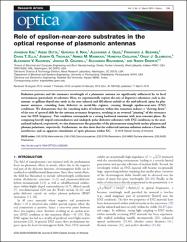Role of epsilon-near-zero substrates in the optical response of plasmonic antennas

Göster/
Erişim
info:eu-repo/semantics/openAccessTarih
2016Yazar
Kim, JongbumDutta, Aveek
Naik, Gururaj V.
Giles, Alexander J.
Bezares, Francisco J.
Ellis, Chase T.
Tischler, Joseph G.
Mahmoud, Ahmed M.
Caglayan, Humeyra
Glembocki, Orest J.
Kildishev, Alexander V.
Caldwell, Joshua D.
Boltasseva, Alexandra
Engheta, Nader
Üst veri
Tüm öğe kaydını gösterÖzet
Radiation patterns and the resonance wavelength of a plasmonic antenna are significantly influenced by its local environment, particularly its substrate. Here, we experimentally explore the role of dispersive substrates, such as aluminum-or gallium-doped zinc oxide in the near infrared and 4H-silicon carbide in the mid-infrared, upon Au plasmonic antennas, extending from dielectric to metal-like regimes, crossing through epsilon-near-zero (ENZ) conditions. We demonstrate that the vanishing index of refraction within this transition induces a "slowing down" of the rate of spectral shift for the antenna resonance frequency, resulting in an eventual "pinning" of the resonance near the ENZ frequency. This condition corresponds to a strong backward emission with near-constant phase. By comparing heavily doped semiconductors and undoped, polar dielectric substrates with ENZ conditions in the near- and mid-infrared, respectively, we also demonstrate the generality of the phenomenon using both surface plasmon and phonon polaritons, respectively. Furthermore, we also show that the redirected antenna radiation induces a Fano-like interference and an apparent stimulation of optic phonons within SiC. (C) 2016 Optical Society of America

















